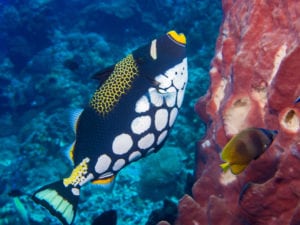Not all Fish Are Reef Safe, Which Fish to Avoid.
It is important to remember a saltwater tank is essentially the closest approximation of a natural marine environment. It is, of course, not the same. Most of the fish and inverts do not live in such close proximity or even in the same eco-system as one another. Many species will not react initially to a new environment but will change behavior as they adapt. This could mean a number of problematic outcomes for your tank & why not all fish and inverts are 100% reef safe.
Furthermore, nothing remains static–what may make for a serene environment at one point can turn chaotic in very short order. The age of a fish, the order in which they are introduced into the tank, or competition for food can result in aggressive behavior against other fish or a change in appetite (i.e. developing a taste for invertebrate [example: Angelfish]).
You will find on almost any discussion threads, all hobbyist have anecdotes about what a specific species or even fish did in their tank. These typically fall into three broad categories: Structure and balance of the ecosystem, aggressive behavior, and appetite/feeding habits.
Structure & Balance of a Saltwater Ecosystem
Corals:
Corals can be vital but hole a somewhat tricky role in any ecosystem. You cannot just toss in anything that looks good. Always look to consult your local saltwater expert on which species are most compatible. With over 800 tropical species of coral, the matrix of combinations can be overwhelming with many engaging in what amounts to “chemical warfare” in the tank.
A few rules of thumb with the more popular species to keep in mind: sarcophyton and lemnalia are considered to be some of the more toxic species. They should not be placed in close proximity to the large-polyp euphyllia types. You will notice the more docile of the two start to lose color and recess within a week’s time.
Fish to Avoid in your Reef Aquarium
Gobies:
Engineer Gobies, although peaceful in nature, can be problematic. They get their commonly used nickname from the fact that they are constantly digging, burrowing or shifting rock and lose coral around the tank. This can often displace shelters and hiding areas for other fish potentially causing higher levels of stress. Also, rock work becomes compromised and are prone to topple. Be mindful when looking to added any of this species.
Angel Fish:
Large Angelfish and Butterflyfish are best kept out of reef tanks with the latter actually classified as corallivores (meaning they only eat coral polyps).

Triggerfish:
Most hobbyists report Triggerfish to be problematic as well, like the clown triggerfish. In addition to their brightly colored appearance and graceful swimming, they are known to be highly inquisitive. This curiosity is a problem because their sharp teeth bite nearly everything (fish and inverts included) to figure out what they are. They sharpen their teeth along coral and gravel causing damage to each. Perhaps it is their famous elegance that belies a true predatory nature. They are carnivores, and will aggressively make short work of invertebrates and smaller docile fish.
Learn more about caring for Triggerfish
Related: Is the Blue Jaw Trigger Reef Safe?
Wrasse:
With over 600 species in the wrasse family divided into nine subgroups, most do well in saltwater tanks. A few of the exceptions are Banana, Bluehead and Christmas Wrasses, along with the Dragon and Formosa Wrasse. Wrasse’s diets specifically focus on crabs, snails, and tubeworms, making them ill-suited for many reef tanks.
Invertebrates, that Aren’t Always Reef Safe
Emerald Crab:
While the emerald crab is typically considered herbivorous and often purchased to remove unwanted algea, it may also take a nip out of your fish and corals. They can tear apart and consume soft corals such as zoanthids. Furthermore, it wouldn’t be uncommon for an emerald crab to knock over corals or rocks while scavaging for uneaten food in crevices. Regardless, they are great cleaners so if you do add an emerald crab to your reef tank, keeping it well fed may reduce some of the adverse effects.
When Deciding What Is or Is Not Reef Safe for Your Tank
The key is to research livestock thoroughly before making a purchase. Don’t buy fish or inverts spontaneously—it’s a risk that can have a devastating effect on your reef tank.
















